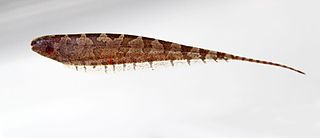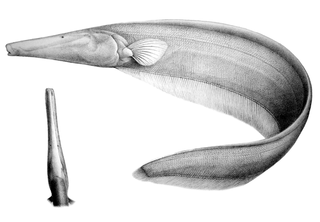
The Gymnotiformes are an order of teleost bony fishes commonly known as Neotropical knifefish or South American knifefish. They have long bodies and swim using undulations of their elongated anal fin. Found almost exclusively in fresh water, these mostly nocturnal fish are capable of producing electric fields to detect prey, for navigation, communication, and, in the case of the electric eel, attack and defense. A few species are familiar to the aquarium trade, such as the black ghost knifefish, the glass knifefish, and the banded knifefish.

The naked-back knifefishes are a family (Gymnotidae) of knifefishes found only in fresh waters of Central America and South America. All have organs adapted to electroreception. The family has about 43 valid species in two genera. These fish are nocturnal and mostly occur in quiet waters from deep rivers to swamps. In strongly flowing waters, they may bury themselves.

The ghost knifefishes are a family, Apteronotidae, of ray-finned fishes in the order Gymnotiformes. These fish are native to Panama and South America. They inhabit a wide range of freshwater habitats, but more than half the species in the family are found deep in rivers where there is little or no light.
Gymnotus is a genus of Neotropical freshwater fish in the family Gymnotidae found widely in South America, Central America and southern Mexico. The greatest species richness is found in the Amazon basin. They are sometimes referred to by the English name banded knifefish, although this typically is reserved for the most widespread species, G. carapo. Overall Gymnotus is the most widespread genus in the order Gymnotiformes.

Glass knifefishes are fishes in the family Sternopygidae in the order Gymnotiformes. Species are also known as rattail knifefishes.

The Hypopomidae are a family of fishes in the order Gymnotiformes known as the bluntnose knifefish. They may also be called grass or leaf knifefishes. These electric fish are not often eaten, of little commercial importance, rarely kept as aquarium fish, and poorly studied; however, species in this family may constitute a significant fraction of the biomass in the areas they inhabit.
Sternarchogiton is a genus of weakly electric knifefish in the family Apteronotidae, with five known species, all living in the main channel of large rivers in the Amazon and Orinoco basins in South America.

Orthosternarchus tamandua, the tamandua knifefish, is a species of weakly electric knifefish in the family Apteronotidae, native to the deep river channels of the Amazon basin. This species is characterized by its whitish-pink color, long tubular snout, long dorsal appendage, and tiny, bilaterally asymmetrical eyes.

Apteronotus is a genus of weakly electric knifefish in the family Apteronotidae, distinguished by the presence of a tiny tail fin. This genus is restricted to tropical and subtropical South America and Panama where found in a wide range of freshwater habitats. They feed on small animals.
Sternarchella, the bulldog knifefish, is a genus of ghost knifefishes found at depths of 2–50 m (7–164 ft) in the main channel of large rivers in South America. Most are from the Amazon basin, but S. orthos is found both in the Amazon and Orinoco, S. orinoco is restricted to the Orinoco and S. curvioperculata restricted to the upper Paraná basin. They are often common in their habitat.
Hypopygus is a genus of South American gymnotiform knifefishes native to the Amazon, Orinoco and upper Paraguay basins, as well as rivers in the Guianas. They are often common, and found near submerged roots, aquatic vegetation and leaf-litter in streams, edges of rivers and floodplains. They are regularly found among vegetation in floating meadows, a habitat that often contains little oxygen, but they are well-adapted to this.
Microsternarchus is a genus of bluntnose knifefish that is found in creeks and streams, often in areas with submerged vegetation, roots and leaf litter, in the Amazon, Orinoco, Essequibo–Rupununi and Río de la Plata basins in South America. The two recognized species are both small knifefish, with the largest being M. bilineatus at up to 12 cm (4.7 in) in total length. The other is M. brevis, which at up to only 5.3 cm (2.1 in) is the world's smallest knifefish. Microsternarchus are very similar to Brachyhypopomus.

Steatogenys is a genus of gymnotiform knifefishes found in the Amazon, Orinoco and Essequibo river basins in tropical South America. The widespread and common S. elegans is found in a wide range of habitats, from the shallow essentially static waters such as floodplain lakes to fast-flowing rivers as deep as 50 m (160 ft). The two remaining species are less common and widespread, with A. duidae found mainly in small streams running through terra firme forests and S. ocellatus among submerged roots and branches in static or slow-flowing blackwater habitats. All three are regularly found among vegetation in floating meadows, a habitat that often contains little oxygen, but they are well-adapted to this.

Eigenmannia is a genus of fish in the family Sternopygidae native to tropical and subtropical South America, and Panama. They are typically found in slow-flowing streams, along the edge of large rivers, in deep river channels and in floodplains, and the genus also includes E. vicentespelaea, the only cave-adapted knifefish. Eigenmannia are often found near submerged roots, aquatic plants and floating meadows.

Sternopygus is a genus of glass knifefishes found in tropical and subtropical South America, and Panama. They inhabit a wide range of freshwater habitats, from fast-flowing rivers to essentially static waters in floodplains, and shallow habitats to the bottom of deep rivers. S. macrurus will even visit brackish mangrove to feed.
Gymnotus tiquie is an electric knifefish found in the Tiquié River, a tributary of the Vaupés River in the upper Negro basin, Amazonas, Brazil. It is sympatric with both G. carapo and G. coropinae. Like the rest of its genus, it is exclusively a freshwater fish. It generates a weak electric field used for both navigation and communication.
Gymnotus choco, commonly known as the cuchillo, is an electric knifefish. G. choco is distinguished from its cogenerate species group by a color pattern possessing pale yellow bands oriented obliquely, wherein the interband margins are wavy or even irregular; one to three Y-shaped dark bands occur on its body's posterior section; and its pale bands do not extend above the fish's lateral line on its body's anterior two-thirds. G. choco is most similar to G. paraguensis from the Pantanal in Brazil and Paraguay. From the latter, it is distinguished by having a narrower mouth, a more cylindrical body, and a longer preanal distance.

Steatogenys elegans, the barred knifefish, is a species of Hypopomidae found in tropical South America. It is the type species of its genus. It is an electric fish found in a wide range of freshwater habitats in the Amazon, Orinoco and Essequibo river basins. It reaches almost 30 cm (1 ft) in total length.

The electric eels are a genus, Electrophorus, of neotropical freshwater fish from South America in the family Gymnotidae. They are known for their ability to stun their prey by generating electricity, delivering shocks at up to 860 volts. Their electrical capabilities were first studied in 1775, contributing to the invention in 1800 of the electric battery.

Melanosternarchus is a genus of ghost knifefish found in the Amazon basin of Brazil and Peru. The single species in this genus, Melanosternarchus amaru is primarily found in the deep channels of large blackwater rivers. This species can be recognized by its large mouth, slender body and an absence of scales on its nape and dorsum. Its maximum recorded size is 272 mm.










